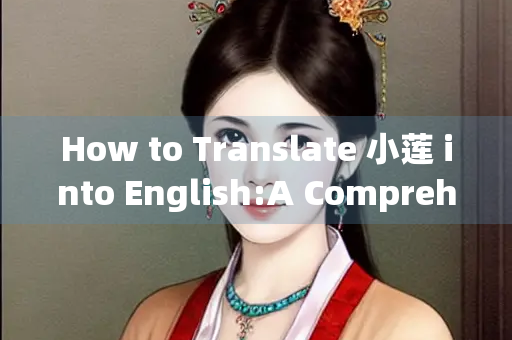Introduction
Names hold significant cu lt ural and personal value, and translating them from one language to another can be a delicate task. The Chinese name "小莲" (Xiǎo Lián) is no exception. This article explores the various ways to translate "小莲" into English, considering linguistic, cultural, and personal preferences. We will examine direct translations, phonetic transliterations, and contextual adaptations to help you choose the most app ropriate version for different situations.

By the end of this article, you will understand:
- The meaning and structure of the name "小莲."
- Common English translations and their implications.
- Cultural considerations when translating Chinese names.
- Practical ex amp les of how "小莲" might appear in different contexts.
Understanding the Name "小莲"
Before translating, it's essential to break down the name's components:
- 小 (Xiǎo) – This character means "small" or "little" and is often used as a term of endearment in Chinese names.
- 莲 (Lián) – This means "lotus," a flower that symbolizes purity, beauty, and resilience in Chinese culture.
Thus, "小莲" can be interpreted as "Little Lotus" or "Young Lotus," conveying a sense of delicacy and grace.
Direct Translation: "Little Lotus" or "Young Lotus"
The most straightforward way to translate "小莲" is by converting each character into its English equivalent:
- "Little Lotus" – This maintains the original meaning while sounding natural in English.
- "Young Lotus" – An alternative that slightly shifts the nuance but retains the floral imagery.
Pros of Direct Translation:
- Preserves the poetic and symbolic meaning of the name.
- Easily understood by English speakers, especially in literary or artistic contexts.
Cons of Direct Translation:
- May sound overly literal in casual or professional settings.
- Loses the phonetic connection to the original name.
Phonetic Transliteration: "Xiao Lian" or "Hsiao Lien"
Another common approach is to use pinyin (the Romanization system for Mandarin Chinese) to represent the name phonetically:
- "Xiao Lian" – The standard pinyin version.
- "Hsiao Lien" – An older Wade-Giles romanization, less common today.
Pros of Phonetic Transliteration:
- Maintains the original pronunciation.
- Commonly used in official documents and international contexts.
Cons of Phonetic Transliteration:
- English speakers may mispronounce it (e.g., "Zee-ow Lee-an" instead of "Sh-ow L-yen").
- Loses the meaning unless explained.
Hybrid Approach: Combining Meaning and Sound
Some people prefer a blend of phonetic and semantic translation:
- "Lian Xiao" (reversing the order to fit Western naming conventions).
- "Lotus Xiao" (keeping "Lotus" while retaining "Xiao" for familiarity).
Pros of Hybrid Translation:
- Balances meaning and pronunciation.
- Adaptable to different cultural contexts.
Cons of Hybrid Translation:
- May still require explanation for full understanding.
- Less conventional than pure transliteration.
Cultural Considerations in Name Translation
When translating names, cultural sensitivity is crucial:
- Personal Preference – Some individuals prefer keeping their names in pinyin, while others like meaningful translations.
- Formality – Official documents often require pinyin, whereas creative works may allow poetic translations.
- Audience – If the name is for an English-speaking audience, a direct translation may be more accessible.
Examples of "小莲" in Different Contexts
Formal/Professional Setting (e.g., Business, Academia)
- Preferred Translation: Xiao Lian (standard pinyin for consistency in documents).
- Example: "Dr. Xiao Lian will present her research at the conference."
Literary or Artistic Context
- Preferred Translation: Little Lotus (emphasizes the poetic meaning).
- Example: "The protagonist, Little Lotus, embodies resilience and grace."
Casual or Social Media Use
- Preferred Translation: Lian (shortened for simplicity) or Lotus (as a nickname).
- Example: "Hey Lotus, are we meeting tomorrow?"
Common Mistakes to Avoid
- Over-literal translations – "Small Lotus" sounds unnatural in English.
- Ignoring name order – In Chinese, the surname comes first (e.g., Li Xiao Lian if "Li" is the surname), but in English, it's often reversed (Xiao Lian Li).
- Assuming one-size-fits-all – The best translation depends on context and personal preference.
Conclusion: Which Translation Should You Use?
There is no single "correct" way to translate "小莲" into English. The best choice depends on:
- Purpose (official, literary, casual).
- Audience (Chinese speakers, English speakers, international readers).
- Personal preference (whether the individual prefers meaning or sound).
Recommended Approach:
- For official use → Xiao Lian (pinyin).
- For storytelling or artistic works → Little Lotus (meaning-based).
- For casual settings → Lian or Lotus (simplified versions).
Ultimately, the translation should respect the name's cultural significance while ensuring clarity and ease of use in English. Whether you choose Xiao Lian, Little Lotus, or another variation, understanding the nuances will help you make an informed decision.
Would you like additional examples or a deeper dive into specific translation scenarios? Let us know in the comments!

